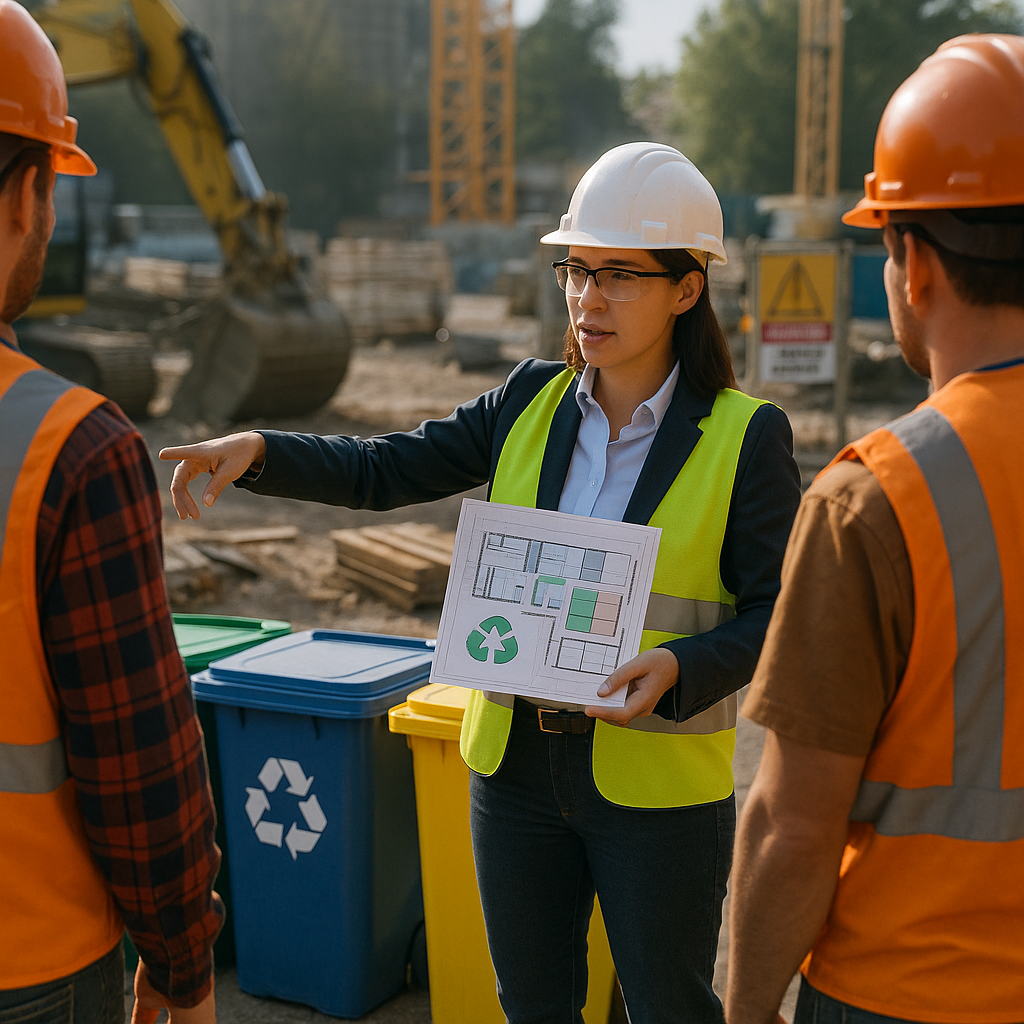5901 Botham Jean Blvd, Dallas, TX 75215
What is Job Site Recycling? Key Benefits and Methods
July 5, 2025Construction and demolition (C&D) waste accounts for an astonishing 30% of global waste. Job site recycling offers a practical solution to this increasing issue, involving the collection, sorting, and processing of C&D materials directly at construction sites rather than transporting them to landfills.
Job site recycling transforms potential waste into valuable resources. Concrete becomes aggregate for new projects, metals find new life in manufacturing, and wood is repurposed into mulch or biomass fuel. The versatility of recycling extends to nearly all construction materials—such as concrete, masonry, wood, asphalt, metal, glass, and plastics—which can all enjoy a second life through proper recycling practices.
The benefits go beyond environmental stewardship. Construction companies that implement job site recycling often experience reduced disposal costs. Projects pursuing LEED certification can earn points through effective waste diversion. Additionally, local communities benefit from reduced landfill pressure and less extraction of virgin materials. This practice represents an exceptional scenario where responsible resource management aligns seamlessly with business interests.
What Are the Key Methods for Job Site Recycling?

Construction and demolition projects generate substantial waste materials that can be recycled. Two primary approaches exist for managing these recyclables efficiently: on-site sorting and off-site sorting (or commingled recycling). Each method offers distinct advantages based on project requirements, space constraints, and recycling goals.
On-Site Sorting
On-site sorting involves separating recyclable materials at the job site into dedicated containers. This approach requires multiple dumpsters, each designated for specific materials such as cardboard, metal, wood, or concrete.
Workers sort materials as they work, placing each type into its appropriate container. The separated materials are then transported to specialized recycling facilities that process each specific material type.
The main advantage of on-site sorting is the higher recycling rebate potential. By preventing cross-contamination between materials, more recyclables remain viable for processing.
- Higher recycling rates due to reduced contamination
- Better quality recyclable materials that fetch better rebates
- Direct environmental benefits through more efficient resource recovery
However, this method requires more space for multiple containers and demands active management. Workers need proper training to sort materials correctly during the construction or demolition process.
Off-Site Sorting
Off-site sorting simplifies the on-site process by using a single container for all recyclable materials. This commingled approach shifts the sorting responsibility to specialized recycling facilities equipped with advanced sorting technology.
Workers place all recyclable debris into one container without separating materials. The filled container is then transported to a recycling plant where materials are separated mechanically and manually.
The primary benefit of off-site sorting is operational efficiency. It requires fewer dumpsters and less space on constrained job sites.
- Lower upfront costs with fewer dumpster rentals needed
- Reduced logistics complexity with fewer hauler deliveries
- Space savings on tight construction sites
- Simplified worker procedures with minimal sorting required
This approach typically costs less than on-site sorting, minimizing equipment needs and simplifying on-site waste management processes. However, material contamination can reduce the overall recycling rate.
Choosing the Right Method for Your Project
Selecting between on-site and off-site sorting depends on several project-specific factors. Space availability can become a determining factor on urban construction sites where room for multiple containers may be limited.
Project budget considerations also influence the decision. Off-site sorting generally offers lower upfront costs but may result in smaller recycling rebates. On-site sorting requires more initial investment but can yield better financial returns through higher-quality recyclable materials.
Environmental goals play a crucial role in the decision-making process. Projects with strict sustainability targets may prefer on-site sorting for its higher recycling rates. Those with tight budgets or space constraints might find off-site sorting more practical.
| Factor | On-Site Sorting | Off-Site Sorting |
|---|---|---|
| Cost | Higher upfront due to multiple dumpsters; better recycling rebate. | Lower overall costs with fewer dumpsters and hauler deliveries. |
| Space | Requires more space for multiple containers. | Requires less space with fewer bins. |
| Time | Time-consuming to set up separate material bins. | Saves time as only one container is needed. |
| Workflow Impact | May hinder workflow due to increased on-site traffic and management needs. | Smoother workflow with less on-site traffic and simpler processes. |
| Recycling Rate | Higher recycling rates due to reduced contamination. | Potential for reduced recycling rates due to material contamination. |
| Environmental Impact | Direct environmental benefits with more efficient resource recovery. | Similar environmental impact if sorted at advanced facilities. |
| Availability and Convenience | Best if local facilities are far or inconvenient to access. | More convenient logistics and easier planning. |
Both methods support the circular economy by diverting construction waste from landfills. The key is selecting the approach that best aligns with your project conditions, budget constraints, and environmental objectives.
How Can Companies Implement Effective Job Site Recycling?

Implementing effective job site recycling requires a systematic approach and commitment from all levels of an organization. Companies that successfully incorporate recycling into their operations not only reduce their environmental footprint but also often realize cost savings through reduced waste disposal fees. Explore the key steps to establish an effective recycling program at your workplace.
Form a Dedicated Recycling Team
The foundation of any successful recycling program begins with assembling the right team. Identify employees who are interested in sustainability initiatives and assign them clear responsibilities. This team will become your recycling champions, driving the program forward and maintaining momentum.
Include representatives from different departments to ensure comprehensive coverage of all workplace areas. These team members will monitor recycling stations, address questions from colleagues, and track progress toward established goals.
Regular meetings allow the team to discuss challenges, share successes, and brainstorm improvements. Their visibility throughout the organization helps reinforce the importance of recycling efforts among all employees.
Conduct a Waste Audit
Before implementing any recycling program, conduct a thorough waste audit to understand the types and quantities of waste your job site generates. This step provides crucial baseline data to shape your recycling strategy and set realistic goals.
During the audit, analyze waste from different areas over several days to get an accurate picture. Identify materials that appear frequently in your waste stream, such as paper, cardboard, plastic, glass, or metal. This information helps determine which recycling streams to prioritize.
The waste audit also highlights opportunities for waste reduction before recycling even begins. Look for ways to minimize waste generation through process improvements or material substitutions.
Establish Clear Recycling Guidelines
Develop straightforward recycling guidelines that specify which materials can be recycled and how they should be prepared. Clear instructions remove confusion and increase participation rates among employees.
Your guidelines should address common questions like whether items need to be cleaned before recycling, if lids should be removed from containers, or how to handle mixed materials. Use simple language and visual aids to make information accessible to everyone.
Post these guidelines prominently near recycling stations and distribute them through company communication channels. Consistency in messaging helps reinforce proper recycling practices throughout the workplace.
Set Up Proper Infrastructure
Convenient access to recycling bins is critical for program success. Place clearly labeled recycling stations throughout your facility, especially in high-waste areas like break rooms, copy centers, and production floors.
Each recycling station should include separate, clearly marked containers for different materials. Consider using color-coding and pictures to make identification easier. Position recycling bins next to trash cans so employees don’t default to landfill disposal out of convenience.
Ensure your recycling infrastructure aligns with the capabilities of your waste management partner. There’s no benefit in collecting materials they cannot process.
Partner with Waste Management Companies
Selecting the right waste management partner significantly impacts your recycling program’s success. Research local providers that specialize in commercial recycling and have proven environmental credentials.
When evaluating potential partners, consider their collection schedules, processing capabilities, and track record for responsible disposal. Ask about their sorting technologies and how they handle contaminated loads.
A strong partnership with your waste management provider offers valuable insights into improving your recycling practices. Many companies provide educational materials, conduct site visits, and offer suggestions to optimize your program.
Educate and Engage Employees
Even the best-designed recycling program fails without employee participation. Develop a comprehensive education plan that explains why recycling matters and how to do it correctly.
Include recycling procedures in new employee orientation and offer regular refresher training for existing staff. Use multiple communication channels like emails, posters, and team meetings to reinforce recycling messages.
Consider launching your program with a kickoff event that generates excitement and demonstrates leadership commitment. Hands-on demonstrations help employees understand exactly what can be recycled and how to prepare items properly.
Monitor Progress and Make Adjustments
Establish metrics to track your recycling program’s performance, such as recycling rates, contamination levels, or cost savings. Regular monitoring helps identify both successes and areas needing improvement.
Work with your waste management partner to obtain data on the volume and types of materials recycled. This information validates your efforts and provides concrete evidence of environmental impact.
Be prepared to adjust your program based on feedback and performance data. Recycling markets and technologies evolve constantly, requiring flexibility in your approach.
Recognize and Reward Participation
Acknowledge departments or individuals who demonstrate exceptional commitment to recycling. Recognition reinforces positive behaviors and encourages continued participation.
Consider friendly competitions between departments to boost engagement. Track metrics like contamination rates or recycling volume and celebrate improvements through company-wide announcements.
Share success stories that highlight the environmental benefits achieved through collective efforts. Connecting daily recycling actions to broader environmental impacts helps maintain motivation.
What Are the Benefits and Challenges of Job Site Recycling?
Environmental Benefits of Job Site Recycling
Job site recycling greatly reduces landfill burden. A single commercial construction project can divert up to 7,000 cubic yards of waste from landfills, the equivalent of two Olympic swimming pools. Preserving landfill space is increasingly critical as disposal sites become scarcer.
Recycling construction materials conserves natural resources by reducing the need for raw material extraction. For instance, recycling one ton of steel saves roughly 2,500 pounds of iron ore, 1,400 pounds of coal, and 120 pounds of limestone that would otherwise be mined. This resource conservation helps protect ecosystems from the destructive effects of mining and quarrying.
The carbon footprint reduction achieved through construction recycling is substantial. Manufacturing cement, a key ingredient in concrete, accounts for about 8% of global CO2 emissions. By crushing and reusing existing concrete as aggregate, companies avoid these emissions while preserving the embodied carbon already invested in these materials.
Economic Advantages for Construction Companies
Cost savings are among the most immediate benefits of job site recycling. Construction firms often face significant landfill fees, which continue to rise as landfill space becomes scarce. By implementing recycling programs, companies can reduce disposal expenses by up to 50% in many regions.
Beyond savings, recycling can generate revenue through the sale of recyclable materials. Metals like steel, copper, and aluminum hold considerable value when sorted and recycled. A medium-sized construction project can often recoup thousands of dollars through the strategic sale of recyclable materials.
A thorough analysis of traditional disposal versus recycling methods shows financial advantages. For a typical commercial construction project generating 500 tons of waste, traditional landfill disposal might cost $25,000-$35,000 in tipping fees alone. A recycling program could reduce this expense to $10,000-$15,000 while generating $3,000-$8,000 in material sales—creating a total financial benefit of $18,000-$28,000.
Social and Regulatory Benefits
Implementing recycling practices enhances a company’s reputation and can lead to competitive advantages. As clients increasingly prioritize environmental responsibility, firms with strong recycling programs gain a distinct edge in bidding processes. This competitive advantage often results in more contracts and higher profitability.
Job site recycling also helps companies meet increasingly stringent environmental regulations. Many municipalities now require minimum recycling rates for construction and demolition projects. Non-compliance can result in substantial fines and project delays. By proactively implementing recycling programs, construction firms avoid these penalties.
In 2022, a commercial redevelopment project in Seattle recycled over 85,000 tons of concrete on-site, saving approximately 8,500 truck trips. This not only reduced the project’s carbon footprint but also minimized traffic disruption to the surrounding community—demonstrating how recycling can improve public relations.
Practical Challenges of On-Site Recycling
Space constraints present significant challenges for job site recycling. Urban construction sites often have limited room for setting up sorting areas and containers needed for effective recycling. Companies must carefully plan their site layout to accommodate these requirements without impeding construction activities.
Contamination of recyclable materials is another major hurdle. When materials like wood are contaminated with paint or other chemicals, recycling becomes more difficult and sometimes impossible. Proper training of workers on appropriate sorting techniques is essential but requires time and resources.
The lack of standardized regulations across different jurisdictions creates compliance challenges. Construction companies operating across multiple regions must navigate varying requirements, increasing administrative burdens. What qualifies as acceptable recycling in one location may not meet standards in another.
Training and logistics coordination also present practical difficulties. Workers need proper education on what materials can be recycled and how to sort them effectively. This requires ongoing training programs and supervision to ensure compliance with recycling protocols.
Overcoming Recycling Obstacles
Mobile recycling units offer an innovative solution to space constraints. These portable systems can be brought directly to construction sites, enabling materials to be processed on-site. This reduces the need for large sorting areas and minimizes transportation costs.
Partnerships with specialized recycling facilities can help address contamination issues. These facilities have the expertise and equipment to handle mixed or partially contaminated materials that might otherwise be difficult to recycle. Establishing relationships with such partners streamlines the recycling process.
The Green Tower residential project in New York City demonstrates successful implementation of construction waste recycling despite space limitations. The development team set an ambitious goal of 85% waste diversion and implemented a comprehensive on-site sorting system. The project ultimately achieved 87% waste diversion while saving $150,000 in disposal costs compared to traditional methods.
Technology is increasingly helping companies overcome recycling challenges. AI-powered sorting systems can identify and separate materials with high precision, reducing labor costs and improving recycling rates. These advanced technologies make recycling more feasible even on challenging job sites.
| Method | Cost for Disposal | Cost for Recycling | Potential Revenue from Recycled Materials | Total Financial Benefit |
| Traditional Disposal | $25,000-$35,000 | N/A | N/A | N/A |
| Recycling | $10,000-$15,000 | $10,000-$15,000 | $3,000-$8,000 | $18,000-$28,000 |
Balancing Benefits and Challenges
While job site recycling presents certain challenges, the environmental and economic benefits typically outweigh the difficulties. Construction companies that develop systematic approaches to recycling can transform these challenges into opportunities for cost savings and competitive advantage.
The construction industry is increasingly recognizing that waste management is not just an environmental concern but a financial one. Companies that view materials as resources rather than waste can unlock significant value. A comprehensive waste management plan that incorporates recycling is becoming standard practice for forward-thinking construction firms.
The future of construction waste management points toward a circular economy approach. This model aims to keep materials in use for as long as possible through strategies like reuse, repair, remanufacture, and recycling. By implementing on-site recycling, construction firms move closer to this ideal while gaining immediate practical benefits.
Conclusion: The Future of Job Site Recycling

Job site recycling has evolved from an optional practice to an essential component of modern construction operations. As regulations tighten and environmental concerns grow, construction companies that implement effective recycling programs are positioning themselves for long-term success. The evidence is clear: recycling construction waste significantly reduces landfill burden, conserves natural resources, and provides substantial cost savings.
The construction industry is moving toward a circular economy model, where materials maintain their value throughout their lifecycle. Advanced technologies like AI-powered sorting systems and mobile recycling units will continue to improve efficiency and expand recycling capabilities. Companies that invest in these solutions today will gain competitive advantages and contribute to a more sustainable future. Contact Okon Recycling at 214-717-4083 for expert guidance on implementing effective job site recycling solutions for your construction needs.
